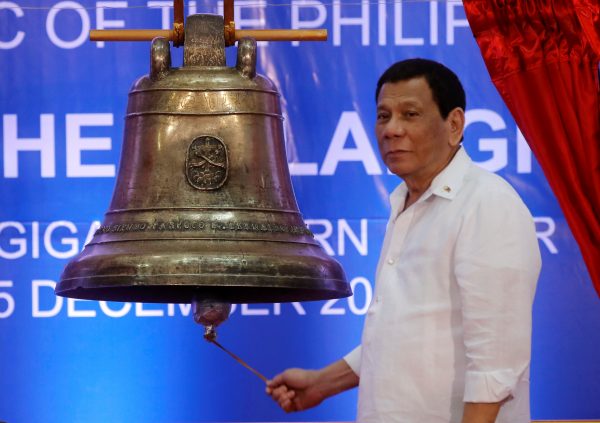In the Philippines the vice president is elected separately, rather than as part of a presidential ticket, and often becomes the central figure in opposition to the incumbent president. This is the case for Vice President Leni Robredo today and why Duterte is hoping that the legal challenge of the 2016 vice presidential runner-up Marcos Jr. will succeed in invalidating Robredo’s election.
While according to the opinion polls Duterte remains overwhelmingly popular (with 80 per cent approval in the latest Social Weather Stations survey), this support seems shallow. On social media it is difficult to distinguish between the genuine ‘diehard Duterte supporters’ and his ‘militia’ of paid trollers. At the elite level, Duterte has helped resuscitate previously discredited political clans, such as that of Gloria Arroyo, Joseph Estrada and Ferdinand Marcos. But their support is transactional, rather than demonstrating ideological commitment or even personal loyalty.
Unlike most autocrats, Duterte has failed to create a mass-based organisation to perpetuate his regime. Both the Kilusang Pagbabago (Coalition for Change) and the Masa Masid failed to gain any traction. The latter movement’s funding was largely cut off by the Senate with the support of some of Duterte’s allies.
Only one paramilitary organisation of concern has been created since Duterte’s inauguration: the National Citizen Militia, which claimed in September 2017 to have some 25,000 members. Since then it has kept a low profile. Given that it is largely comprised of former military personnel, its principal role may well be to maintain the Armed Forces of the Philippines’ behind-the-scenes centrality in the political system — especially as Duterte’s anti-Americanism goes against the grain of the officer class.
By ending any attempts at negotiation with the New People’s Army (the armed branch of the Communist Party of the Philippines) and through his pro-capitalist economic policies, Duterte has also alienated what existed of his elite left-wing power base. Above all, Duterte’s so-called war on drugs — resulting in some 20,000 extra-judicial killings with over 5,000 directly acknowledged by a distrusted police force — overwhelmingly targeted the poorest of the poor in the slums of Manila, a central pillar of Duterte’s electoral constituency. Their continued support for his presidency seems acquiescent at best given large-scale disenchantment with a dysfunctional democratic system, as a whole, and the lack of ideologically structured political parties to propose an alternative.
The Philippines’ mid-term elections in May 2019 could very possibly announce the beginning of the end for Duterte. There were 152 candidates enrolled at the Electoral Commission’s 17 October 2018 deadline for the 12 seats in the Senate to be contested. Given there is no primary system, their election or re-election is not dependent on their degree of allegiance to the incumbent President. In short, the solidity and local rootedness of Filipino political dynasties are formidable obstacles to Duterte’s continued survival.
This situation may well be exacerbated by Duterte’s proposed constitutional changes to create a federal system after 2022. The House of Representatives, led by Duterte’s ally Gloria Arroyo, voted measures to eliminate term limits in early December 2018 and prohibited Duterte from running again under a new constitution.
Duterte’s assertive ‘bi-aligned’ foreign policy has also had a boomerang effect. His pro-Chinese pivot has brought few tangible investment results outside of Duterte’s own bulwarks in the Visayas and Davao. It allowed the disparate opposition led by Vice President Robredo to take on the mantle of being the true nationalists by appealing to the underlying anti-Chinese sentiment of a proud Filipino people. Meanwhile the United States, both through the indispensable support provided in the recapturing of Marawi and through the return of the Balangiga bells, has neutered Duterte’s capacity to use an anti-United States mantra as a mobilising trope.
Will the putative end of Duterte’s autocratic regime mean an end to the slide into authoritarian rule that he has engendered? Duterte’s daughter, Sara Duterte Carpio, is attempting to set up a coalition of minor regional parties to support her run for the Senate. With a 39.5 per cent approval rating in a September 2018 Pulse Asia poll, she is somewhat of a shoo-in. She has also reached out to Marcos Jr., whose sister Imee seems also virtually assured of re-election, to make sure that her father can leave office without fear of future punishment.
After inveighing against the elite of Imperial Manila, the irony would be that Duterte leaves office having re-established dynastic Filipino politics. But this return to dynastic politics is fraught with difficulties. Duterte was elected on the grounds that the People Power Revolution of 1986 — carried out in the name of the people, but not by the people — had failed to deliver the public goods to the aspiring lower middle class and the poor who voted for him. In the most inegalitarian society in Asia, there is a need for democracy to be accompanied by a degree of economic equality by strengthening the role of an impartial, just and redistributive state. Otherwise another strongman saviour may well re-emerge in the future.
David Camroux is Honorary Senior Research Fellow at Sciences Po (CERI) in Paris and Visiting Professor at the Vietnam National University (USSH) in Hanoi. He is the Dissemination Coordinator for a major EU-funded project, Competing Regional Integrations in Southeast Asia (CRISEA).
This article is part of an EAF special feature series on 2018 in review and the year ahead.

